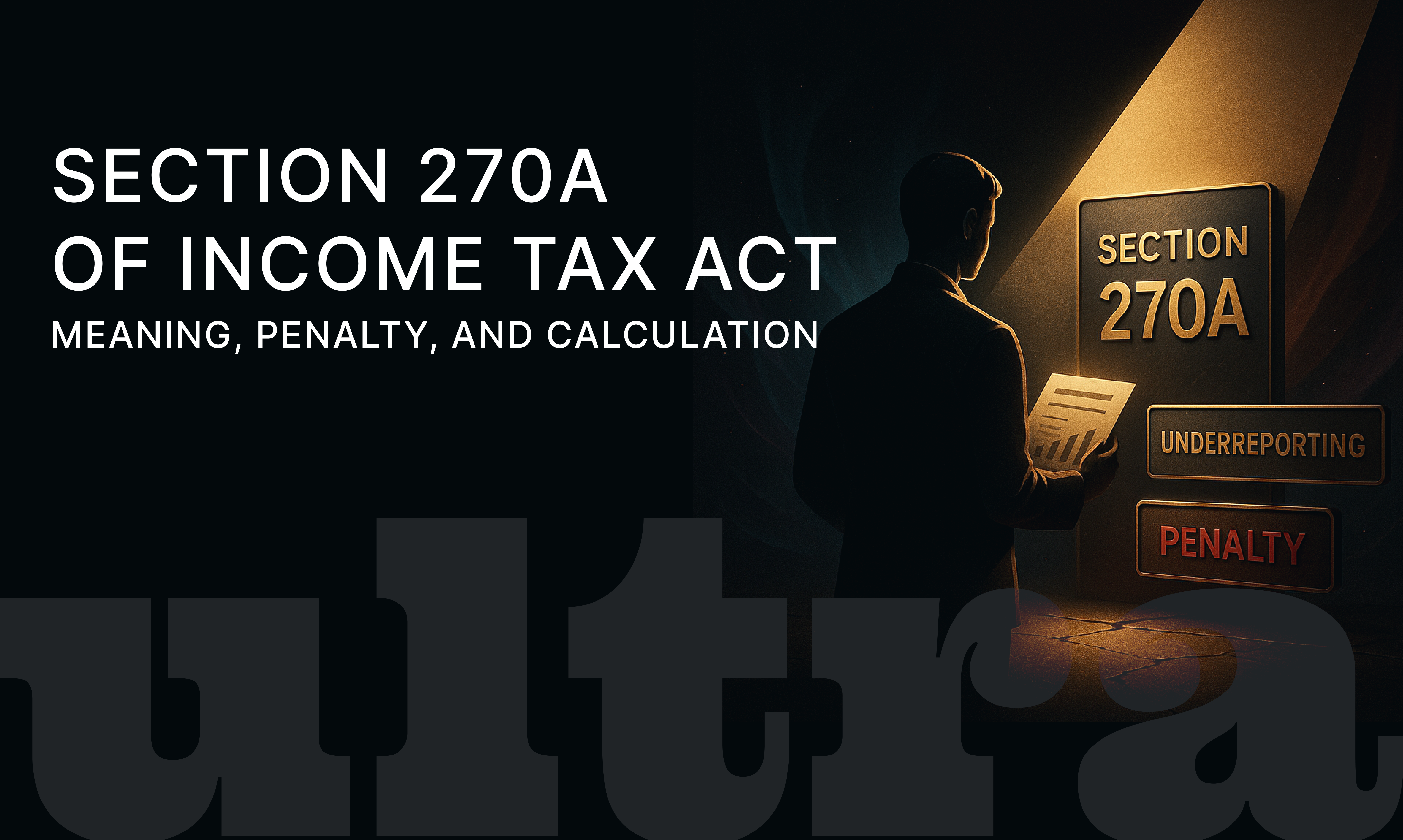What is Section 270A of Income Tax Act?
18 July 2025 · Sachin Gadekar
Understanding Section 270A of Income Tax Act: How Penalties for Under-Reporting Work

What is Section 270A of Income Tax Act?
Section 270A of Income Tax Act is one of the key provisions every taxpayer in India must understand. Introduced by the Finance Act, 2016, it aims to tackle cases of under-reporting and misreporting of income with clearer definitions and stricter penalties than the older rules.
In this guide, Ultra explains what Section 270A covers, the difference between under-reporting and misreporting, how to calculate penalty under Section 270A with a practical example, and how taxpayers can avoid falling into non-compliance.
Section 270A empowers the Income Tax Department to penalise taxpayers who under-report or misreport their income. It replaces the older Section 271(1)(c), which dealt with concealment and inaccurate particulars of income. The new section provides clearer guidelines and penalty rates, leaving less room for disputes.
When Does Section 270A Apply?
Section 270A applies when a taxpayer files a return with an income figure that is lower than what is later assessed by the Income Tax Department. If the department discovers this difference during assessment, the taxpayer may be penalised under Section 270A.
Penalty for Under-Reporting and Misreporting
The penalty depends on whether the shortfall is due to under-reporting or misreporting.
Under-Reporting of Income: 50 percent of the tax payable on the under-reported income.
Misreporting of Income: 200 percent of the tax payable on the misreported income.
Difference Between Under-Reporting and Misreporting
Under-Reporting happens when income is understated without intentional fraud. It could result from errors, omissions, or wrong calculations.
Misreporting involves deliberate acts such as claiming fake expenses, manipulating accounts, or hiding facts.
How to Calculate Penalty Under Section 270A With Example
Let’s take a simple example.
Suppose you filed your Income Tax Return for the year and declared your taxable income as Rs 12 lakh. However, during assessment, the Assessing Officer finds that your actual taxable income should have been Rs 18 lakh. So, the under-reported income is Rs 6 lakh.
Step 1: Calculate tax on under-reported income.
Assume the tax rate is 30 percent. Tax on Rs 6 lakh is Rs 1,80,000.
Step 2: Calculate penalty.
If it is under-reporting: Penalty is 50 percent of Rs 1,80,000 = Rs 90,000.
If it is misreporting: Penalty is 200 percent of Rs 1,80,000 = Rs 3,60,000.
How to Avoid Penalty Under Section 270A
1. File Accurate Returns
Always declare all your income sources. Do not hide salary, freelance earnings, interest income, or capital gains.
2. Avoid False Deductions
Claim deductions only if you are genuinely eligible. Keep proof for investments and expenses.
3. Keep Proper Records
Maintain proper books of accounts, bank statements, invoices, and supporting documents.
4. Respond to Notices on Time
If you receive an intimation or notice from the tax department, reply promptly with accurate details.
5. Seek Professional Advice
If your finances are complex, consult a tax expert or chartered accountant to ensure compliance.
What Happens If You Receive a Penalty Notice
If the Assessing Officer believes there is under-reporting, they will issue a notice. You will be given a chance to explain. If you can justify the difference with valid evidence — for example, a genuine calculation error — the penalty may be reduced or not levied.
Other Related Sections
Section 270AA: Provides immunity from penalty under certain conditions if the taxpayer pays the tax and interest in full and does not appeal.
Section 271AAC: Deals with penalty on unexplained income under sections 68, 69, etc.
Why Knowing Section 270A Matters
Whether you are a salaried professional, business owner, or investor, understanding Section 270A of Income Tax Act helps you stay tax-compliant. It encourages honest reporting, supports fair tax collection, and discourages fraudulent practices.
FAQs
Q1. What is the penalty under Section 270A of Income Tax Act?
The penalty is 50 percent of the tax on under-reported income or 200 percent of the tax if income is misreported.
Q2. How do you calculate penalty under Section 270A?
Find the tax on the under-reported income and multiply it by 50 percent (for under-reporting) or 200 percent (for misreporting).
Q3. What is the difference between Section 270A and 271(1)(c)?
Section 271(1)(c) dealt with concealment of income and was subjective. Section 270A clearly defines under-reporting and misreporting with fixed penalty rates.
Q4. Can I avoid penalty under Section 270A?
You can avoid penalty by filing accurate returns, maintaining correct documents, and responding honestly during assessment.
Q5. What happens if I misreport my income?
If you intentionally misreport your income, the penalty will be 200 percent of the tax on the misreported amount.
Final Thoughts
Section 270A of Income Tax Act aims to promote honest income reporting and reduce tax evasion. For peace of mind and smooth financial management, always check your returns, keep your paperwork ready, and consult trusted tax advisors when needed.
For more investment and tax-related insights, keep reading Ultra — your trusted guide for smarter investing.